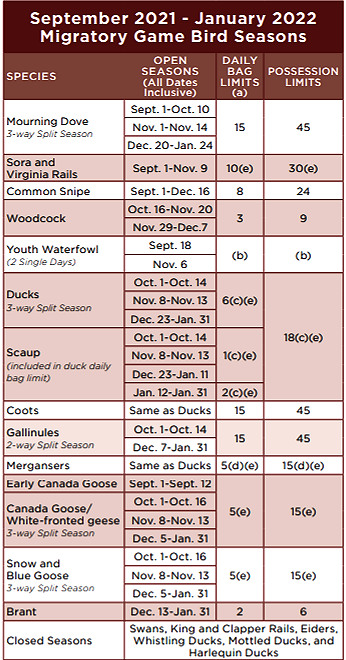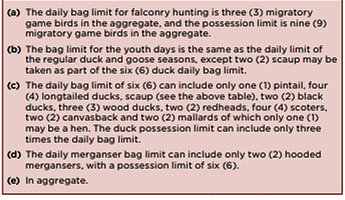“Our added winter moisture and active calling period led to a very long nesting and hatching season, starting in late April and extending into early summer, with chicks hatching as late as early July,” O’Dell said. “From a population standpoint, we are out of a deficit for the first time since 2001-2002. Quail are starting to pop up in places they haven’t been seen in a while.
“If you’ve never had the chance to experience what Arizona quail hunting built its name on, then this would be the year to get out and enjoy it.”
Meanwhile, hunters should note that the season for Mearns’ quail doesn’t begin until Dec. 4. It’s summer rainfall that plays a key role in nesting success and population numbers of this species. After a spotty and relatively weak monsoon across southern Arizona, these birds are likely to be abundant only in pockets that received sufficient precipitation this summer.
A valid Arizona hunting or combination hunt and fish license is required for all hunters 10 and older. Those hunters under 10 must either have a valid hunting or combination hunt and fish license, or be accompanied by an adult who possesses a valid hunting or combination hunt and fish license. Licenses can be purchased online or at license dealers statewide. A youth combination hunt and fish license (ages 10 to 17) is $5.
The general bag limit is 15 quail per day in the aggregate, of which no more than eight may be Mearns’ quail (when the Mearns’ season opens Dec. 4). The general possession limit is 45 quail in the aggregate after opening day, of which no more than 15 Gambel’s, scaled or California quail in the aggregate may be taken in any one day. After the opening of the Mearns’ season, the 45-quail possession limit may include 24 Mearns’ quail, of which no more than eight may be taken in any one day.
More quail-hunting information can be found on the department’s website at https://www.azgfd.com/Hunting/. Another resource for both new and experienced hunters alike is “An Introduction to Hunting Arizona’s Small Game.” Written by Randall D. Babb, the 196-page, full-color book covers where and how to hunt small game birds (like quail), squirrels, rabbits, ducks and geese. It also includes how to prepare and cook your harvest, with illustrations and recipes. The book can be ordered for $16.95 at www.azgfd.gov/publications.
Finally, hunters should check out O’Dell’s techniques for field-dressing quail at https://www.youtube.com/watch?v=3gRwZAcWzzk.
####
Publishers Notes: OUT OF STATE HUNTERS, FISHERMEN & OUTDOOR ENTHUSIASTS; Due to the Covid 19 pandemic, there could be limitations for OUT of STATE hunters, fishermen and other outdoor enthusiasts to include a 14-day quarantine requirement or negative COVID-19 testing alternative. Please check with the State's Department of Natural Resources BEFORE you travel or apply for the 2020 Fall Hunts.
Disclaimer: The views expressed on this site are that of the authors and not necessarily that of TBC Press
West Virginia Waterfowl Regulations set for the 2021-22 Season
Submitted by: TBC Press
Posted on: 08/24/21
The Backcountry Press
The country's premier daily HUNTING, FISHING & OUTDOOR news in the USA and around the globe. Read whats happening in your neck of the woods & beyond.
© 2020 TBC Press - All Rights Reserved Website Design by:
News # 14491
The waterfowl regulations are set for the West Virginia 2021-22 season. The seasons are set within the guidelines established annually by the U.S. Fish and Wildlife Service.
“There are two notable changes for this year. First, the definition of ‘bait’ now includes any non-edible facsimile of an edible enticement, like plastic ear corn. Second, a permit is no longer required to hunt at the Green Bottom Wildlife Management Area, although hunting hour restrictions remain in place for the first three days of the October segment,” said Mike Peters, WVDNR waterfowl biologist. “As always, please review the West Virginia Migratory Bird Hunting Regulations Summary for any changes.”
All information on West Virginia’s migratory game bird seasons can be found in the 2021-2022 West Virginia Migratory Bird Hunting Regulations available online at WVdnr.gov.
Federal regulations require all licensed migratory bird hunters, including lifetime and senior citizens, to register with the Migratory Bird Harvest Information Program (HIP) and carry proof of registration while hunting. HIP cards are free and available at all hunting license agents and online at WVhunt.com.
Additionally, all waterfowl hunters 16 years and older must possess a federal Migratory Bird Hunting and Conservation Stamp or “Duck Stamp” which is signed by the hunter across the stamp’s face. Duck Stamps can be purchased from your local U.S. post office, by calling 1-800-782-6724, or going to USPS.com/shop. Hunters should report harvested banded birds online at reportband.gov.
####














